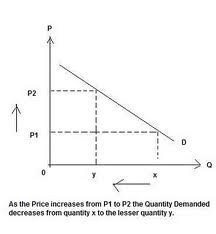![]()
![]()
![]()
Use LEFT and RIGHT arrow keys to navigate between flashcards;
Use UP and DOWN arrow keys to flip the card;
H to show hint;
A reads text to speech;
15 Cards in this Set
- Front
- Back
|
What is the first law of demand?
|
The law of demand states that, if all other factors remain equal, the higher the price of a good, the less people will demand that good. In other words, the higher the price, the lower the quantity demanded.
|
|
|
What is the slope of the demand curve?
|

Top left to bottom right.
|
|
|
What is effective demand?
|
Demand in economics must be effective which means that only when a consumers' desire to buy a product is backed up by an ability to pay for it does demand actually have an effect on the market.
|
|
|
What is market demand?
|
Market demand is the sum of the individual demand for a product from each consumer in the market. If more people enter the market and they have the ability to pay for items on sale, then demand at each price level will rise.
|
|
|
Define demand.
|
Demand is defined as the quantity of a good or service that consumers are willing and able to buy at a given price in a given time period.
|
|
|
What do we mean when we talk about individual demand in the economics sense?
|
Each of us has an individual demand for particular goods and services and the level of demand at each market price reflects the value that consumers place on a product and their expected satisfaction gained from purchase and consumption.
|
|
|
What is latent demand?
|
Latent demand is probably best described as the potential demand for a product. It exists when there is willingness to buy among people for a good or service, but where consumers lack the purchasing power to be able to afford the product. Latent demand is affected by advertising – where the producer is seeking to influence consumer tastes and preferences.
|
|
|
What is derived demand?
|
The demand for a product X might be strongly linked to the demand for a related product Y – giving rise to the idea of a derived demand. For example, the demand for steel is strongly linked to the demand for new vehicles and other manufactured products, so that when an economy goes into a downturn or recession, so we would expect the demand for steel to decline likewise.
|
|
|
What do we mean when we talk about the ceteris paribus assumption?
|
Understanding ceteris paribus is the key to understanding much of microeconomics. Many factors can be said to affect demand. Economists assume all factors are held constant (ie do not change) except one – the price of the product itself. A change in a factor being held constant invalidates the ceteris paribus assumption
|
|
|
What does the demand curve actually show?
|
A demand curve shows the relationship between the price of an item and the quantity demanded over a period of time.
|
|
|
There are two reasons why more is demanded as price falls. What are these?
|
The Income Effect: There is an income effect when the price of a good falls because the consumer can maintain current consumption for less expenditure. Provided that the good is normal, some of the resulting increase in real income is used by consumers to buy more of this product.
The Substitution Effect: There is also a substitution effect when the price of a good falls because the product is now relatively cheaper than an alternative item and so some consumers switch their spending from the good in competitive demand to this product. |
|
|
Is the demand curve a straight line in reality?
|
No, the demand curve is normally drawn in textbooks as a straight line suggesting a linear relationship between price and demand but in reality, the demand curve will be non-linear! No business has a perfect idea of what the demand curve for a particular product looks like, they use real-time evidence from markets to estimate the demand conditions and they accumulated experience of market conditions gives them an advantage in constructing demand-price relationships.
|
|
|
What causes a movement along the demand curve?
|
A change in the price of a good or service causes a movement along the demand curve. A fall in the price of a good causes an expansion of demand; a rise in price causes a contraction of demand.
|
|
|
What causes a shift in the demand curve to the left or right?
|
Many other factors can affect total demand - when these change, the demand curve can shift. We say that this is due to a change in one of the determinants of demand.
|
|
|
What are the determinants of demand?
|
Prices of other goods – e.g. prices of Substitutes and Complements
Consumer incomes – including both the level and distribution of income Tastes and preferences of consumers The level and age-structure of the population Price expectations of consumers for future time periods |

